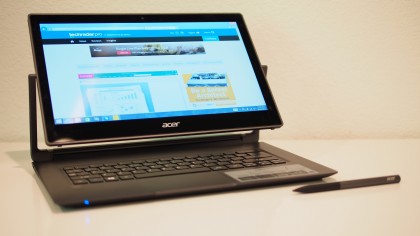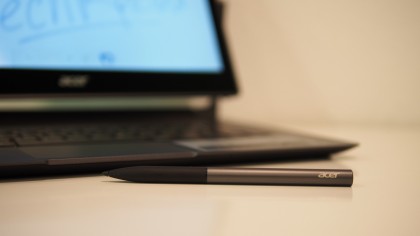Why you can trust TechRadar
Equipped with Intel's latest Broadwell processors and integrated graphics, the performance of the Aspire R13 is consistent with the Ultrabook category, posting similar results to the Dell XPS 13 and the Zenbook UX305.
Benchmarks
- PCMark 8: Home: 2,258; Work: 2,190
- PCMark 8 Battery Life: 3 hour and fifteen minutes (50% screen brightness)
- 3DMark: Fire Strike: 656; Cloud Gate: 3,716; Sky Diver: 2,248
- Cinebench: GPU: 26.22 fps; CPU: 207
Performance
Although within range, the results show that in many of the categories, the Aspire R13 fared slightly worse than the Ultrabook average. The higher WQHD resolution display, compared to a standard full HD display on standard Ultrabook, may be a culprit of the slightly degraded performance numbers.
Despite having a weaker Intel Core i5 processor and the same Intel HD 5500 integrated graphics, the Dell XPS 13 with QHD+ display fared better than the Aspire 13 in graphics tests.
Dell's XPS 13 posted better performance in all three 3DMark benchmarks than the Aspire R13, scoring 4,935, 2,745 and 739 for the Cloud Gate, Sky Diver and Fire Strike tests respectively. The Aspire R13 performed better in the PCMark Home test, posting a score of 2,258, compared to the 2,104 on the XPS 13. Processor performance using the Cinebench tool is also higher on the XPS 13, with a score of 258 compared to the 207 on the Aspire R13.

Similarly, despite an even weaker Intel Core M processor on our Asus Zenbook UX305 review and lesser HD 5300 graphics, the performance difference compared to the Aspire R13 is negligible. It's unclear why the Aspire R13 didn't post stronger numbers given its Broadwell Core i7 processor.
The Zenbook UX305 posted similar CPU scores to the Aspire R13 with the Cinebench test, but the GPU performance is weaker with a score of 21.28 fps compared to the 26.22 fps on the Aspire R13.
In my real-world usage, despite degraded numbers, the Aspire R13 had no issues opening multiple apps, running multiple Chrome tabs, working with Adobe Photoshop and basic video editing with Adobe Premiere.
Sign up to the TechRadar Pro newsletter to get all the top news, opinion, features and guidance your business needs to succeed!

The problem I had with the Aspire R13 is that the Ultrabook runs warmer than competitors like the MacBook Air and the ThinkPad T450s. With heat output being high, though not overly hot that the Aspire R13 couldn't be used on a lap, the fan would kick in, and fan noise became an issue.
Another issue with noise is that unless the Aspire R13 is fully shut down, I found that my review unit emitted a high pitch buzz when it is put to sleep. Unless you have sensitive ears, most users likely wouldn't notice this high pitch buzz.
Battery life is commendable, but not great. The Aspire R13 managed just under seven hours of continuous usage with screen brightness set to 50% performing various tasks as occasional photo cropping in Photoshop, streaming YouTube videos, browsing the internet on multiple Chrome windows and running the Pidgin messaging client in the background.
Digital inking
Unlike the Surface Pro 3, digital inking is more of a bonus afterthought on the Aspire R13. The Acer Active Stylus is an optional $50 (£35, AU$65) accessory, and one that is usable, but lacks the sensitivity and precision of the Surface Pen.
Despite Acer's claim of 255 levels of pressure sensitivity, I found that pressure sensitivity is not as precise as the pens for the Surface Pro 2 or Surface Pro 3, when used for drawing and painting. Additionally, palm rejection is a mixed bag on the Aspire R13. For taking notes, I found that the unit would sometimes not recognize and reject my palm when I am using the pen, resulting in my hand registering errant inputs on the screen.

The pen seems more suited for casual use than for creative professionals and digital artists. It's fine to mark up a PDF for edits and comments, sign digital documents, or the occasional sketches, but creative professionals likely may want to look at other options for more precise work.
